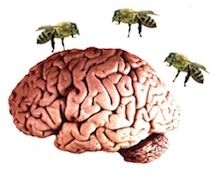
(Image adapted from photos by Wolfgang Hagele and John A Beal, Wikimedia Commons)
Our brains may have evolved to forage for some kinds of memories in the same way, shifting our attention from one cluster of stored information to another depending on what each patch has to offer. Recently, Thomas Hills of the University of Warwick in England and his colleagues found experimental evidence for this potential parallel. "Memory foraging" is only one way of thinking about memory - and it does not apply universally to all types of information retained in the brain - but, so far, the analogy seems to work well for particular cases of active remembering.
Hills and his colleagues asked 141 Indiana University Bloomington students to type the names of as many animals as they could think of in three minutes. For decades, psychologists have used such "verbal fluency tasks" to study memory and diseases in which memory breaks down, such as Alzheimer's and dementia. Again and again, researchers have found that people name animals - or vegetables or movies - in clusters of related items. They might start out saying "cat, dog, goldfish, hamster" - animals kept as pets - and then, having exhausted that subcategory, move onto ocean animals: "dolphin, whale, shark, octopus."
On average, the students in Hills's experiment named 37 animals in three minutes and, like so many of their predecessors, the lists they typed were organized into groups of animals unified by a single theme - pets, the savanna, etcetera. What Hills and his colleagues really wanted to know was whether the students shifted from one themed cluster to another the same way some animals hop from patch to patch of food. To make the most of its time and get the most food possible, a bird feeding on berries, for example, should only stay on any one particular bush if the plant will yield more berries than nearby bushes. At some point, the bird has eaten so many berries on the first bush that it makes more sense to switch to one with more to offer.
Scientists who study animals have translated this kind of decision-making into mathematical equations called "optimal foraging models," which Hills applied to the lists of animals produced by the students in his experiment. Hills coded a computer program that first decided the probability that a student would name a particular animal, given what the student had already named. If someone started with "cat," for instance, they are much more likely to next type "dog" than "zebra." When the program encountered a pair of words that were unlikely to appear together, followed by a pair of words with a much higher chance of coupling, it interpreted the pattern as a jump from one themed cluster to another - such as from pets to savanna. Human jurors independently verified that the program identified jumps in the right places. Finally, the program compared its analysis of how the students navigated their memories with what optimal foraging models predicted the students should do, as if they were birds feeding on berries or bees in a field of wildflowers.
Most students jumped from memory cluster to cluster exactly as the optimal foraging models predicted - and the students whose mental acrobatics most closely matched the models' predictions named the most animals. Hills's program further revealed that the most successful students abandoned one category of animals for another when it took too long to name a new animal, just as a foraging animal leaves behind a patch of food when its time would be better spent at a more fruitful patch. The findings appear online in the February 13 issue of Psychological Review.
"My initial reaction was, "Wow, it worked!" Hills says. "It is pretty cool, and not that common, that some crazy idea works out. This particular line of reasoning seems to be producing some interesting things. A lot of previous research supports the hypothesis that higher-level cognitive abilities evolved from spatial foraging mechanisms. Before we had abstract thinking, we had brains that helped us get around physical spaces - some of those abilities may be co-opted to search in information space."
Peter Pirolli, a research fellow at the Palo Alto Research Center in California who has studied how foraging theories apply to memory, sees the new findings as strong experimental support for an idea that is increasingly popular. "The general sense that searching for things in the world might have been exapted [sic] to other purposes, such as searching for information internally, is a meme that got started in the 1990s," he explains. "I see more and more work applying this aspect of behavioral ecology not just to memory but to all kinds of search and task management."



"Before we had abstract thinking, we had brains that helped us get around physical spaces - some of those abilities may be co-opted to search in information space."
If anyone is interested, you may wanna check out the theory that the brain evolved to control movement: [[Link]
Surfing the waves of thought, IS movement.
Fascinating, food for thought, pun intended